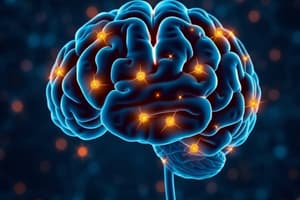Podcast
Questions and Answers
Which two structures are part of the basal ganglia?
Which two structures are part of the basal ganglia?
- Amygdala and thalamus
- Hippocampus and hypothalamus
- Globus pallidus and putamen (correct)
- Caudate and occipital lobe
What is the primary function of the HPA axis?
What is the primary function of the HPA axis?
- To regulate sleep patterns
- To release dopamine
- To control heart rate
- To cope with stress (correct)
What are mirror neurons?
What are mirror neurons?
- Cells that are active during movement and while watching someone else perform the same movement (correct)
- Cells that regulate emotional responses
- Cells that help us visualize our dreams
- Cells that are active during REM sleep
Which type of stroke is caused by a blood clot?
Which type of stroke is caused by a blood clot?
Which brain structure is involved in emotional regulation and depression?
Which brain structure is involved in emotional regulation and depression?
What is the difference between retrograde and anterograde amnesia?
What is the difference between retrograde and anterograde amnesia?
Flashcards are hidden until you start studying
Study Notes
Neuroscience Facts and Concepts
- Two types of strokes: Ischemic (blood clot) and Hemorrhagic (bleeding in the brain)
- Three structures of basal ganglia: Globus pallidus, putamen, and caudate
- PGO waves are electrical impulses that occur during REM sleep
- Occipital lobe visualizes what we're dreaming, sending signals to the pons to paralyze our body
- The Frozen Addicts: Cooked heroin wrong, creating hazardous pesticides called MPTP
- SM lost the ability to fear due to calcification of the amygdala, while HM lost the ability to make new memories due to surgery
- Broadmann Area 25 is involved in depression and emotional regulation
- Retrograde amnesia is forgetting things before getting sick, while anterograde amnesia is trouble remembering things after getting sick
- Explicit memory is remembering facts or events, while implicit memory is remembering skills
- Mirror neurons are cells that are active during movement and while watching someone else perform the same movement
- The primary structures that make up the Limbic System are the hippocampus, amygdala, hypothalamus, and thalamus
- The HPA axis is a system that helps cope with stress, releasing cortisol to deal with stress
Neuroscience Facts and Concepts
- Two types of strokes: Ischemic (blood clot) and Hemorrhagic (bleeding in the brain)
- Three structures of basal ganglia: Globus pallidus, putamen, and caudate
- PGO waves are electrical impulses that occur during REM sleep
- Occipital lobe visualizes what we're dreaming, sending signals to the pons to paralyze our body
- The Frozen Addicts: Cooked heroin wrong, creating hazardous pesticides called MPTP
- SM lost the ability to fear due to calcification of the amygdala, while HM lost the ability to make new memories due to surgery
- Broadmann Area 25 is involved in depression and emotional regulation
- Retrograde amnesia is forgetting things before getting sick, while anterograde amnesia is trouble remembering things after getting sick
- Explicit memory is remembering facts or events, while implicit memory is remembering skills
- Mirror neurons are cells that are active during movement and while watching someone else perform the same movement
- The primary structures that make up the Limbic System are the hippocampus, amygdala, hypothalamus, and thalamus
- The HPA axis is a system that helps cope with stress, releasing cortisol to deal with stress
Studying That Suits You
Use AI to generate personalized quizzes and flashcards to suit your learning preferences.



